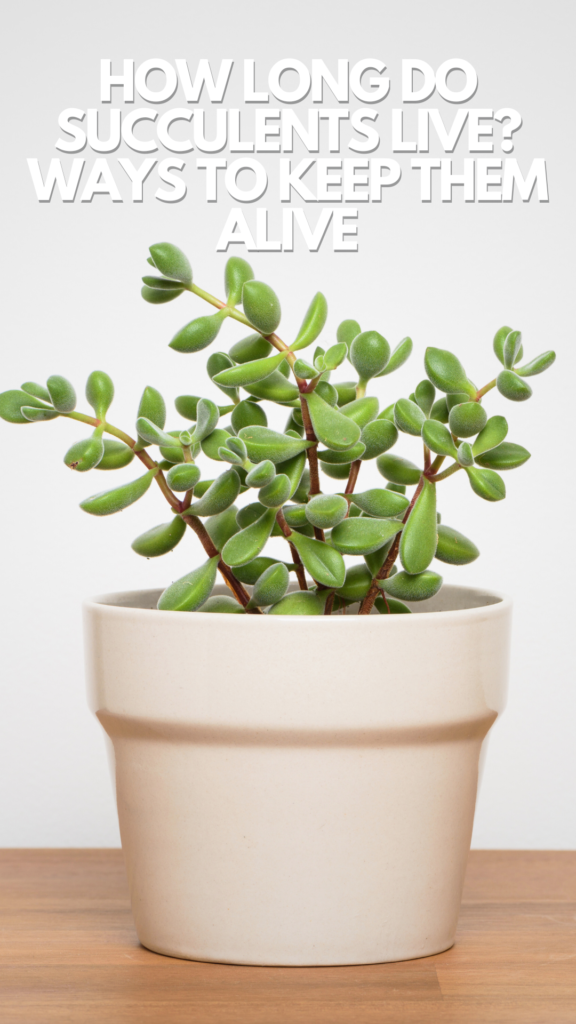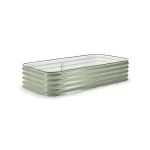Are you wondering how long do succulents live? Succulents plants have gained popularity in recent years due to their low-maintenance nature and unique appearance. They have been given as presents for this exact reason. These hardy plants are well-suited for both indoor and outdoor environments, making them a versatile addition to any home or garden. As with any other living organisms, the lifespan of succulents can vary drastically depending on factors such as species, care, and environment.
In general, succulents can live anywhere from a few years to several decades. Some species, like the Sempervivum, have a relatively short life cycle, reaching maturity within three to four years, then dying after producing offsets. Others, like the Agave, have a significantly longer life expectancy, with some specimens living up to 30 years or more. Proper care, including enough sunlight, having enough water, and minimal exposure to extreme temperatures, plays a critical role in ensuring a succulent’s long and healthy life.
FTC DISCLOSURE: Some of the links in this post are affiliate links. If you click on them and make a purchase, I will receive a small finder’s fee on the sale. This does not increase your price in any way shape or form. Using these links help support the continuation of this website. All opinions are my own. Thank you in advance.
Although it may not be possible to predict the exact lifespan of a specific succulent, understanding the factors that contribute to their longevity can help enthusiasts maximize the life of these fascinating plants. By providing the right balance of care and attention, indoor and outdoor succulents alike can thrive and provide lasting beauty to any space they inhabit.
You Might Also Like To Read:
DIY Neem Oil Spray For Indoor Plants
Understanding Succulent Lifespan
What’s the Average Lifespan of a succulent plant?
Succulents are generally plants with a long lifespan, with many species having a lifespan of more than 10 years. However, the exact lifespan of succulents can vary significantly depending on the species, genetics, and environmental factors. For instance, some species like Sempervivum and Echeveria may live for 3-5 years, whereas a few hardy plants like Aloe and Agave can thrive for 20-30 years or even more in ideal conditions.
Factors Influencing Lifespan
There are several factors that can influence the lifespan of succulents:
- Genetics: As mentioned earlier, some succulent species are naturally predisposed to having a longer or shorter life expectancy. Genetic factors play an essential role in determining the plant’s natural lifespan.
- Environmental conditions: Succulents require specific environmental conditions to thrive and reach their full lifespan potential. These requirements include adequate sunlight, proper watering, well-draining soil, and suitable temperature ranges. If these conditions are not met, the succulent’s lifespan might be shorter than expected.
- Pest management: Succulents are susceptible to various pests, such as mealybugs, aphids, and spider mites. Timely identification and appropriate management of these pests are crucial for maintaining the plant’s health and, consequently, its lifespan.
- Proper care: Regular maintenance and care, such as pruning dead leaves, repotting when needed, and supplementing nutrients, contribute significantly to the overall health and longevity of succulents.
Succulent Growth and Dormancy
Growth Cycle
Succulents are unique and versatile plants that boast a wide range of shapes, colors, and sizes. Their growth cycle typically involves two distinct phases: the active growth phase and the dormant phase. During the active growth phase, succulents exhibit rapid growth, absorbing water and nutrients from their environment. This period usually occurs in spring and summer when the temperature and sunlight conditions are optimal for their development.
It is essential to provide proper care for succulents during the active growth phase, including appropriate watering, feeding, and pruning. Succulents generally do not require as much water as other plants, but they still need regular watering during this time. A good rule of thumb is to water them generously when the soil is dry and allow excess water to drain away. Providing enough light is also crucial, as succulents thrive in bright, indirect light. Some species may even require direct sunlight for a few hours each day.
Do succulents need a Dormancy Period
The dormancy period is a phase in the succulent growth cycle where the plant slows down its growth and conserves energy. This period typically occurs during the colder months of the year, particularly in winter, when the temperature and sunlight exposure decrease. Succulents are well-adapted to endure these harsh conditions due to their ability to store water in their leaves, stems, and roots.
During the dormancy period, succulents require even less water than during the active growth phase. It is essential to reduce the frequency of watering while still ensuring the soil does not become completely dry. Overwatering during this time can lead to root rot and other health issues, so it is vital to strike the right balance. Additionally, temperature and light conditions should be carefully monitored to prevent any potential damage to the plants.
Common Long-Lived Succulents
Aloe Vera
Aloe Vera is a popular succulent species known for its medicinal properties. This plant can live a long time, with a typical lifespan ranging from 5 to 25 years. Aloe Vera plants prefer well-drained soil and indirect sunlight, making them a good choice to maintain in most indoor environments. Their leaves store water, allowing them to thrive even in dry conditions. A healthy Aloe Vera plant will produce offsets, or “pups,” that can be removed and replanted to propagate.
Jade Plant
Crassula ovata, commonly known as the Jade Plant, is another long-lived succulent species. These plants can live for several decades, with reports of some reaching over 100 years old. Jade Plants grow gradually and develop a thick, woody stem along with succulent leaves. They require moderate sunlight and well-draining soil, making them suitable for indoor growth. Regular pruning can help maintain their shape and encourage branching.
Barrel Cactus
The Barrel Cactus is a hardy succulent species that can live up to 30 years or more. They are named for their cylindrical shape and spiny exterior. Barrel Cacti thrive in arid and sunny environments, making them best suited for outdoor growth in desert-like conditions. Overwatering is a common mistake when taking care of Barrel Cacti, as they require minimal water to survive due to their natural habitat.
While many people have these species of succulents indoors, the most important factor to keeping it happy is providing it a lot of sunlight indoors. If you are not able to provide it with that much sunlight, please consider buying a grow light for plants. It will provide the bright light indoors that these plants need.
Hens and Chicks
Hens and Chicks, or Sempervivum, is a group of succulents known for their unique rosette shapes and ability to propagate easily. These plants can live between 3 and 20 years, depending on the specific species and care provided. They perform well in various environments, including rock gardens and containers. Hens and Chicks require well-draining soil and adequate sunlight to thrive. The parent plant, or “hen,” will produce several offsets, or “chicks,” which can be separated and replanted to grow new plants.
Caring for Succulents
Light Requirements
Succulents thrive in areas with plenty of natural sunlight. Typically, they need at least 6 hours of bright, indirect sunlight per day. Some species can tolerate hours of direct sunlight, while others may require protection from intense afternoon sun. To ensure optimal lighting, it’s a good idea to rotate your indoor succulents every few weeks to promote even growth. With low light and too little water, even the toughest types of succulents will not survive.
Watering Techniques
When it comes to watering succulents, the key is moderation. Overwatering can cause root rot and eventually kill the plant. The best approach is to use the soak and dry method, which involves thoroughly soaking the soil and then allowing it to dry out completely before the next watering. Wait for the soil to feel completely dry before repeating the process, which usually takes about 2-3 weeks. I like to place my plants in a bucket or bathtub with water and let them water from the bottom of the plant instead of sprinkling in water from the top.
Soil and Drainage
Proper soil and drainage are essential for healthy succulent growth. A well-draining soil mix is crucial to prevent standing water and root rot. You can use a commercial cactus mix or make your own mixture by combining:
- 2 parts coarse sand
- 2 parts potting soil
- 1 part perlite or pumice
Plant your succulents in containers with drainage holes, and avoid using decorative pots without an effective drainage system.
Temperature and Humidity Control
Succulents can tolerate a wide range of temperatures but generally prefer a temperature range of 55-85°F (12-30°C). Most succulents can tolerate short periods of temperatures outside this range, but prolonged exposure may cause damage. Avoid placing them near drafts, air conditioning vents, or heaters.
As for humidity, succulents do well in average indoor environments, with a relative humidity between 40-50%. If your space has higher humidity, ensure proper ventilation, and employ a dehumidifier if necessary.
Succulent Propagation and Offsets
Methods of Propagation
Succulents have several ways to reproduce, ensuring their survival and longevity. Here are the most common methods:
- Offsets: Also known as offshoots or pups, offsets are small plants that grow from the base of the parent plant. To propagate succulents through this method, carefully remove the offset from the parent plant, let the cut area dry for a day or two, and then place the offset on well-draining soil to establish roots before watering.
- Cuttings: Cuttings can be taken from the stems, leaves, or both of a succulent plant. Make a clean cut, allow the cutting to dry for a few days to form a callous, and then place it on well-draining soil. Wait for it to develop roots before watering.
- Seeds: Succulents can also be grown from seeds, although this method is less common due to the longer time required for germination and development when compared to offsets and cuttings.
Growing From Seeds
Growing succulents from seeds has unique challenges but can be rewarding as it allows for more plant variety. Follow these steps for successful seed propagation:
- Selecting Seeds: Purchase high-quality seeds from a reputable source to ensure better germination rates and plant health.
- Sowing Seeds: Prepare a well-draining soil mix and fill small pots or seed trays. Sprinkle the seeds on the soil surface, and then lightly cover them with a thin layer of sand or fine soil.
- Maintaining Conditions: Place the pots or trays in a warm area with indirect sunlight. Maintain a consistent temperature of about 70°F (21°C) for optimal germination.
- Watering: Mist the seeds gently using a spray bottle to keep the soil moist but not overly wet. Avoid direct watering, which may disturb or dislodge the seeds.
- Germination: Depending on the species, succulent seeds may take anywhere from a few weeks to several months to germinate. Continue to provide consistent temperature, lighting and moisture conditions during this period.
Once the seedlings have grown large enough, transfer them to their individual pots and care for them as you would with mature succulents.
Dealing with Pests and Diseases
Common Pests
Succulents may occasionally experience infestations from common pests such as mealybugs, spider mites, and aphids. To control these pests, it is essential to inspect plants regularly and take immediate action upon detection.
- Mealybugs: Remove them using a cotton swab dipped in rubbing alcohol or use a suitable insecticide.
- Spider mites: Wash the plants gently with water or use miticides to eliminate them.
- Aphids: Apply insecticidal soap or neem oil to protect succulents from these pests.
Disease Prevention
Succulent diseases are typically caused by overwatering and poor maintenance. Ensuring appropriate care will help prevent most diseases.
- Avoid overwatering: Maintain a proper watering schedule, allowing the soil to dry between watering sessions to prevent root rot.
- Provide adequate light: Succulents require sunlight to thrive. Place them in a location that receives ample sunlight or use artificial lighting.
- Ensure proper air circulation: Good air circulation reduces humidity around the plants and decreases the risk of fungal diseases.
- Use sterilized tools: Clean and sterilize garden tools to prevent the spread of diseases while pruning or repotting.
By being aware of common pests and practicing diligent care, you can keep your succulents healthy and prolong their lifespan.
Maximizing Succulent Lifespan
Succulents are known for their low-maintenance nature and ability to thrive in various conditions. However, to ensure that these plants live as long as possible, proper care and attention are essential. This section will discuss the best practices to maximize the lifespan of succulents.
It’s crucial to provide succulents with the appropriate environment. Generally, these plants thrive in bright, but indirect sunlight. Placing them near a south or east-facing window is ideal. Moreover, proper airflow is essential to prevent any moisture buildup, which can lead to diseases and damage.
When it comes to watering, succulents prefer a thorough soaking followed by a period of drying out. A good rule of thumb is to water them once the soil has completely dried. Over-watering can cause root rot, significantly shortening the plant’s lifespan. Ensure that you use a well-draining soil mix and containers with drainage holes to prevent waterlogging.
Fertilizing succulents helps promote healthy growth and maintain their vibrant colors. It’s recommended to use a balanced, water-soluble fertilizer during the active growing season, which usually occurs in spring and summer. Apply the fertilizer once a month, following the package instructions for proper dilution. Avoid over-fertilizing, as this could lead to weak and leggy growth.
Regular maintenance is key to keeping succulents healthy and increasing their longevity. This includes:
- Pruning: Trim off dead or damaged leaves and stems to encourage new growth and maintain a tidy appearance. This will also help prevent pests and diseases.
- Pest control: Inspect succulents periodically for signs of pests, such as mealybugs or spider mites. Take immediate action by applying a suitable pesticide or using natural remedies, depending on the severity of the infestation.
- Repotting: Succulents grow slowly but may outgrow their containers over time. Repot your succulents when they become root-bound or the soil begins to break down. Choose a pot that’s slightly larger than the current one and fill it with a well-draining soil mix.
Implementing these practices in your succulent care routine will greatly contribute to extending their lifespan and preserving their unique beauty for many years to come.














